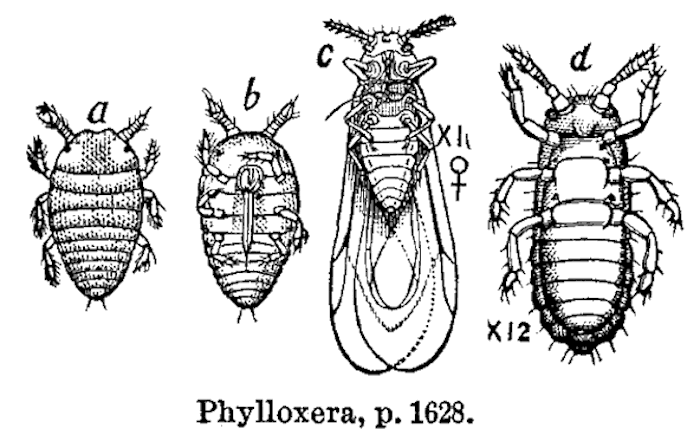Wine Word of the Week: "Phylloxera"
Our latest Wine Word of the Week is phylloxera, a big word that refers to a tiny, sap-sucking root louse that loves to feast on the roots of vitis vinifera grapevines. By feeding on the grapevine however, the flow of nutrients to the plant is cut off, causing it to eventually die. Since the 1800's, phylloxera's predilection for these "vinifera" vines, which produce such well known wines as Cabernet Sauvignon and Chardonnay, has had a devastating impact on the history of the world's fine wine industry.Phylloxera was introduced to the vineyards of Europe in the mid 1800's when two English botanists unknowingly brought back infected vine cuttings from America. Since the pesky louse originated in America, indigenous grapevines were naturally resistant. However, Europe's vinifera vines had no natural protection and an epidemic quickly took hold. The first signs of infestation manifested in France's Southern Rhone in 1863. The louse subsequently spread like wildfire and, by the late 1800's, almost 90% of Europe's vineyards and it's grape growing industry had effectively been destroyed. Ironically, the source of the problem also turned out to be its salvation. After experimenting with a few different methods, it turned out that grafting vinifera vines onto naturally resistant, American rootstocks was the best way to combat the scourge of phylloxera. Thankfully, the resistant rootstocks offered protection without affecting the taste or development of the vinifera grapes as other experimental methods had. Phylloxera also had a significant impact on the vineyards of California where it also became important to graft vines onto the most resistant rootstocks available. While the debate continues as to which rootstocks are most ideal, the practice of grafting continues to this day.While phylloxera has found its way into most wine regions of the world, a few have managed to remain untouched. These include Chile, due to its geographic isolation; the island of Santorini in Greece because of its sandy, ashy soils which the phylloxera louse hates; and most of the continent of Australia. Needless to say, these regions continue to be vigilant about preventing this pest from infesting their grapevines.I hope you enjoyed our latest Wine Word of the Week! To see previous installments, please click here. If there’s a wine word you’d like to learn more about, please leave it in the comment section below!Cheers,
Ironically, the source of the problem also turned out to be its salvation. After experimenting with a few different methods, it turned out that grafting vinifera vines onto naturally resistant, American rootstocks was the best way to combat the scourge of phylloxera. Thankfully, the resistant rootstocks offered protection without affecting the taste or development of the vinifera grapes as other experimental methods had. Phylloxera also had a significant impact on the vineyards of California where it also became important to graft vines onto the most resistant rootstocks available. While the debate continues as to which rootstocks are most ideal, the practice of grafting continues to this day.While phylloxera has found its way into most wine regions of the world, a few have managed to remain untouched. These include Chile, due to its geographic isolation; the island of Santorini in Greece because of its sandy, ashy soils which the phylloxera louse hates; and most of the continent of Australia. Needless to say, these regions continue to be vigilant about preventing this pest from infesting their grapevines.I hope you enjoyed our latest Wine Word of the Week! To see previous installments, please click here. If there’s a wine word you’d like to learn more about, please leave it in the comment section below!Cheers,
